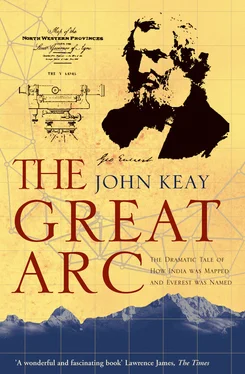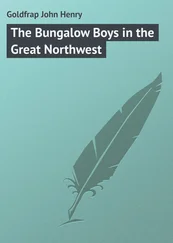More prosaically, it was conceived by an elusive genius called William Lambton and was inspired by the first British conquests in the extreme south of India. The year was 1800. In North America Meriwether Lewis and William Clark had yet to set out on their epic journey across the continent. Australia was barely a penal colony; Napoleon still held Egypt; and most of the rest of Africa remained shrouded in that mysterious ‘darkness’ which was simply Europe’s ignorance.
Only in Asia, and especially India, was an embryonic imperialism detectable. Already the infant was outgrowing the womb of trade, stretching and kicking prodigiously, and taking its first unsteady strides towards dominion. Just so the Great Arc. Mirroring the progress of empire, it would forge tentatively and then inexorably inland. During forty years of high-risk travel, ingenious improvisation and awesome dedication it would come to embrace the entire length of India. And when Lambton, its endearing founder, died in central India, it would be carried to its grand Himalayan finale by the bewhiskered and cantankerous martinet who was Colonel George Everest.
At the time the scientific world was frankly amazed. The Arc was hailed as ‘one of the most stupendous works in the whole history of science’. It was ‘as near perfect a thing of its kind as has ever been undertaken’. Lambton and Everest ‘had done more for the advancement of general science than … any other body of military men’. Their celebrity was assured. Lambton was internationally fêted. George Everest was knighted by Queen Victoria; and in his honour that peak, whose discovery and measurement the Arc had made possible, was duly named.
Yet today they are utterly forgotten. Lambton is not even among the fifteen thousand worthies included in Chambers’ Biographical Dictionary. Everest is just a mountain. The progress of nineteenth-century invention was such that their science was almost instantly superseded. It now features only in histories of cartography, in academic critiques of imperialism, and in the dusty records of the Indian Survey. The Great Arc, like the great auk, has been consigned to oblivion.
Which is a pity, for it deserves better. At a time when to foreigners India was more a concept than a country, a place of uncertain extent and only fanciful maps, the Great Arc and the surveys based on it were indeed tools of imperial dominion as well as scientific enterprises. But thanks to that voluminous documentation and to George Everest’s published memoirs, the story of the Great Arc transcends both its science and its politics. Uniquely for an official scientific venture, we can savour the setbacks, share the excitement, discern the personalities. In writing this book the challenge has not been that of embroidering bare facts with vivid shades of plausible detail but of stitching into the riot of authentic adventure a thread of scientific and political plausibility. Given half a chance, jungle mishaps would have put paid to the science, personal vendettas would have obliterated the politics, and the tigers would have made off with the narrative.
If the impression given is less that of a scientific set-piece and more of a monumental example of human endeavour, then so it was. Travelling India with an eye on the Arc, I found it impossible not to become obsessed by the sheer audacity of the enterprise. Like Mount Everest, which seen from afar looks a respectable peak but not obviously the world’s highest, so the Arc viewed from a distance of two hundred years looks impressive but slightly quixotic. Get up close, though, breathe the sharp air and sense the monstrous presumption, and the Arc like the mountain soars imperiously to dwarf all else. Measuring the one, like climbing the other, is revealed as the ultimate challenge of its age.
The word ‘jungle’ comes from India. In its Hindi form of jangal , it denotes any area of uncultivated land. Indian jungles are not necessarily forested, and today less so than ever. But well away from centres of population there do still survive a few extensive and well-wooded jungle tracts, especially in eastern and central India. Often they are classed as game sanctuaries, a designation which implies few facilities for the visitor but some much-advertised protection for the wildlife.
Here tigers and elephants yet roam, hornbills flap about in the canopy like clumsy pterodactyls, and hump-backed boar rootle aggressively through the leaf mould. In the dry season a safari might seem an attractive prospect. But be warned: ‘dry’ is high-baked. Like splintering glass, dead leaves explode underfoot to alert the animals. The tracks of crumbled dirt are hard to follow, spiked with ferocious thorns, and spanned by man-size webs patrolled by bird-size spiders.
The wet season is worse still. Then, the vegetation erupts. The tracks become impassable, and the air fills with insects. Only fugitives take to the jungle in the monsoon. Fugitives and, in days gone by when maps were rare, surveyors. In the year 1819, in just such a tract between the Godavari and Kistna rivers in what is now the south-eastern state of Andhra Pradesh, an English Lieutenant, lately attached to the Great Trigonometrical Survey of India and uncommonly keen to make his mark, underwent a baptism of fever.
Matters had gone badly for the twenty-eight-year-old Lieutenant from the start. Barely a month into this, his first season in the field, he had been confronted by a mutiny. ‘The infliction of corporal punishment is an odious task,’ he noted. But it was either that or abandoning the assignment. His escort obviously knew the perils of the monsoonal jungle and had seized every chance of escaping from the camp back to the city of Hyderabad. Something had to be done. Not without misgivings, the Lieutenant ordered one of these defaulters to be thrashed, whereupon the whole troop, about forty in number, took up their weapons and announced that they would decamp en masse. The British bluff had been called; in this insignificant and still today unfashionable corner of the subcontinent the myth of empire was at stake.
As might be inferred, by 1819 the British were already well on their way to becoming masters of India. Some areas had been won by conquest and were now under direct British rule; others were merely attached by treaty and remained nominally independent states under their own rulers. This was the case with the large principality of Hyderabad, through whose densest jungle the Kistna and Godavari rivers converged on the coast. Special permission had been obtained for the Great Trigonometrical Survey to operate in Hyderabad; but in ‘a native state’ the standards of subservience exacted in areas under direct British rule could not be taken for granted.
In fact, they could seemingly not be taken at all other than at the point of a gun. The mutineers, who now repaired to the nearby shade of a mango orchard, comprised a detachment of local troops lent by Nizam Sikander Jah of Hyderabad to protect and assist the British survey. In addition, the Survey had its own escort of twelve men who had been recruited in British territory, were paid out of the Survey’s budget and had already amassed many years of loyal service. This in-house escort was now ordered to load muskets and take aim at the mutineers. A volley into their midst was threatened if they did not immediately surrender.
The ploy worked. The mutineers submitted, and this time the Lieutenant offered no apology for calling for the cane. Three men were publicly flogged, then dismissed; and thus, the Lieutenant tells us, ‘was settled, very early in my career, a disputed point which had been a source of constant contention and annoyance to Colonel Lambton ever since his entering into the Nizam’s territory’.
Читать дальше












